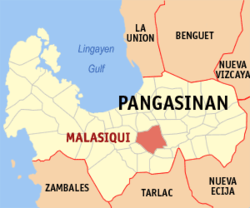Malasiqui, Pangasinan
| Malasiqui | ||
|---|---|---|
| Municipality | ||
 |
||
|
||
 Map of Pangasinan showing the location of Malasiqui |
||
| Location within the Philippines | ||
| Coordinates: 15°55′N 120°25′E / 15.917°N 120.417°ECoordinates: 15°55′N 120°25′E / 15.917°N 120.417°E | ||
| Country |
|
|
| Region | Ilocos (Region I) | |
| Province | Pangasinan | |
| District | 3rd district of Pangasinan | |
| Founded | January 22, 1671 | |
| Barangays | 73 | |
| Government | ||
| • Mayor | Noel Anthony Geslani | |
| • Vice Mayor | Armando Domantay Sr. | |
| • Electorate | 70,990 voters (2016 election) | |
| Area | ||
| • Total | 131.37 km2 (50.72 sq mi) | |
| Population (2015 census) | ||
| • Total | 130,275 | |
| • Density | 990/km2 (2,600/sq mi) | |
| Time zone | PST (UTC+8) | |
| ZIP code | 2421 | |
| 015524000 | ||
| IDD : area code | +63 (0)75 | |
| Income class | 1st municipal income class | |
| Revenue | ₱ 30,560,656.24 (2016) | |
| Poverty incidence | 19.10 (2012) | |
Malasiqui (Pangasinan: Baley na Malasiqui; Ilocano: Ili ti Malasiqui) is a 1st class municipality in the province of Pangasinan, Philippines. According to the 2015 census, it has a population of 130,275 people.
It is mainly an agricultural municipality with rice, corn and tropical lowland vegetables as main crops. It is also famous for its mango fruits having one of the largest concentration of mango tree population in the Philippines.
The word Malasiqui originates from the Pangasinan root word lasi meaning lightning. With prefix ma indicating high degree and suffix qui indicating place - Malasiqui means "place full of lightning".
The municipality traces its origins during the middle of the 17th century when Spanish friars opened a mission intended to convert the native population to Catholicism. The most probable founding year was 1671 when Spanish civil authorities in Manila gave the license for the creation of the town. There were no organized communities in the area before the Spaniards arrived. Attempts to group families into a settlement may have started as early as 1665. The present site was then heavily forested with small family groups scattered along banks of small rivers and creeks. The socio-political history of the municipality parallels that of the Pangasinan province and the country in general. Its history is punctuated by periods of foreign domination first by the Spanish, then by the United States and briefly by the Japanese during the 2nd World War. The population participated heavily in some of the bloodiest rebellions during the Spanish period. Catholicism and other Christian sects dominate the religious life of the people. Ethnically, it is one of the few places in the province of Pangasinan which did not experience in-migration from other regions of the country. Consequently, Pangasinanse is the dominant ethnic group with almost no other ethnic groups mixing into the locality.
The poblacion or town center, is recently experiencing high commercial growth spurred mainly by high consumer spending generated by increase in family incomes attributable to earnings of OFWs (Overseas Filipino Workers). The estimate of OFW population as a percentage of adult labor force is as much as 22% - one of the highest rates in the Philippines. The OFW phenomenon is so significant that almost all households have at least one member working outside of the country.
...
Wikipedia


